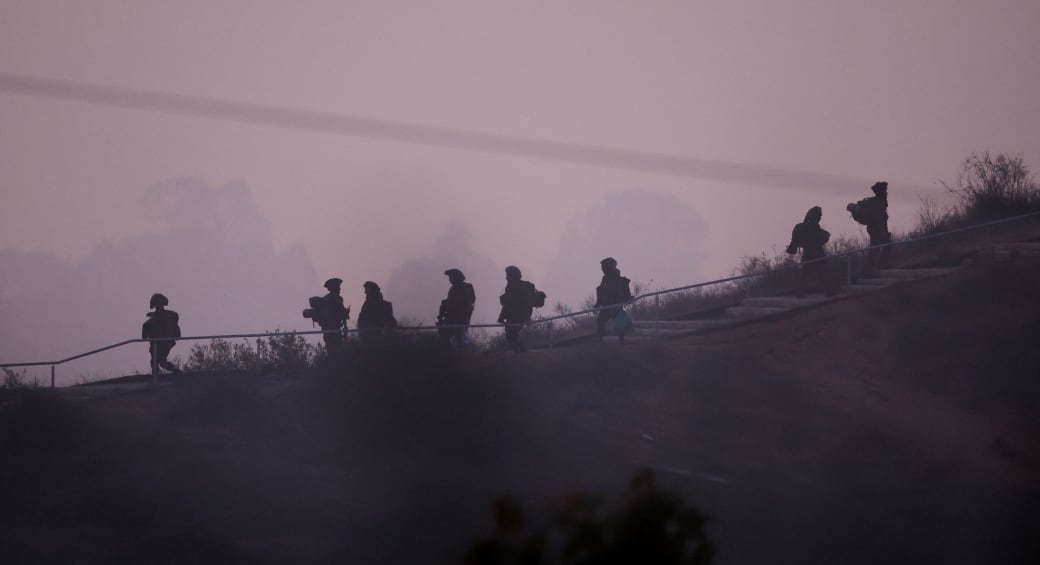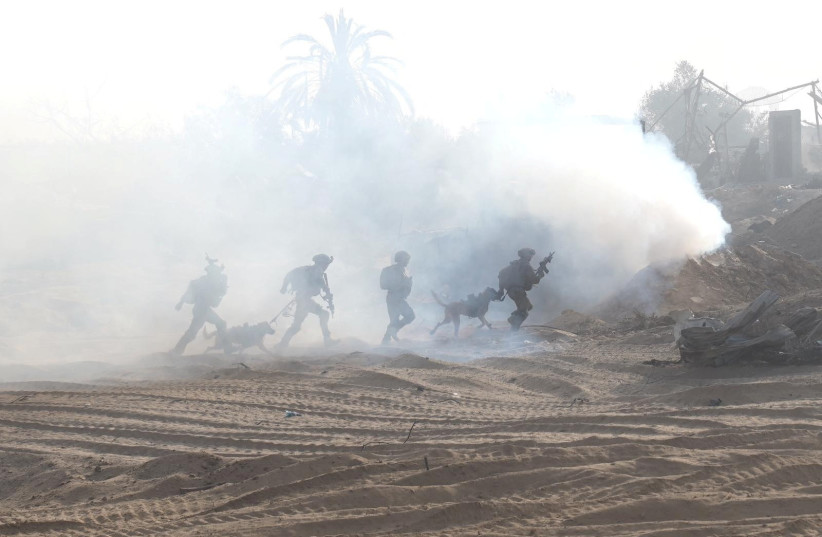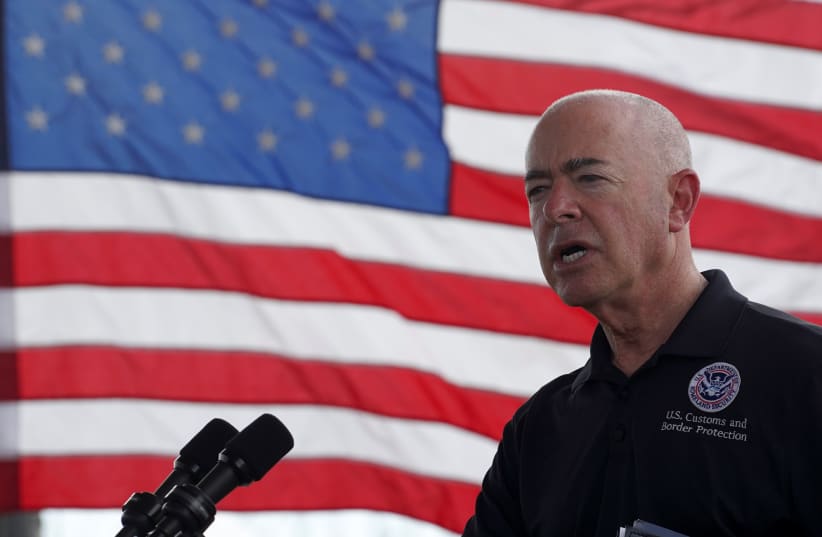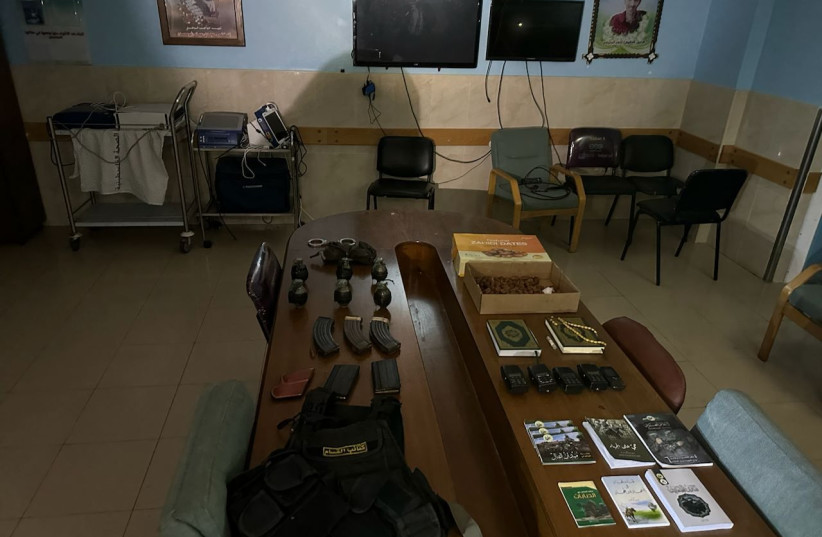Israel at war: What happened on day 41?
1,200 people murdered since October 7, including 372 soldiers • 237 held hostage by Hamas, four hostages released, one rescued


IDF's next steps in Gaza: Hostage deal or southern offensive? - analysis
Defense Minister Yoav Gallant discussed on Thursday moving the war forward to new stages, but conspicuously did not refer to going South.

There is a debate at the highest levels of the government and the IDF about whether the military should already begin its invasion of southern Gaza or whether this must wait for an interim deal on hostages, The Jerusalem Post has learned.
Numerous leaks have been made about terms that Israel or Hamas wants as the sides negotiate what might be an interim deal getting significant numbers of Israeli civilian hostages back, but not all hostages, for some kind of pause and prisoner exchange, but not necessarily that Hamas has demanded.
Whether Israel agrees to a deal or not which Hamas has been desperate for, even the possibility of being close to a deal may currently be slowing the push into southern Gaza, the Post understands.
The concept is that this is a unique tipping point where the IDF has mostly taken over northern Gaza and could make a natural pause.
Go to the full article >>Iran reveals its role behind Hamas holding hostages - analysis
Iran’s foreign minister meets with ICRC president and discusses Hamas holding "prisoners."

Iranian pro-regime media on Wednesday discussed Iran’s meeting with the International Committee of the Red Cross (ICRC).
The Iranian regime held a meeting with the president of the ICRC, according to Iran’s own regime media Press TV and Fars News. Iran’s Press TV also says that “the Israeli regime has, throughout the war, been stonewalling Hamas' ‘positive approaches’ concerning the issue of the prisoners of war.”
This would appear to indicate that Iran has a role in Hamas’ hostage-taking. Iran has backed Hamas in the wake of the October 7 attack. Iran’s media refers to “civilian prisoners” held by Hamas and discusses the “readiness for exchanging more," which could indicate Iran is directly in contact with Hamas and representing the terror group in talks with the ICRC.
"The American administration too has ramped up the intensity of the war on Gaza with its all-out presence and support for the Zionist regime," Hossein Amir-Abdollahian said in a meeting with Mirjana Spoljaric Egger, president of the International Committee of the Red Cross (ICRC), in Geneva on Wednesday, Iran’s Press TV reported.
Foreign minister Eli Cohen demanded the Red Cross to do more to establish contact with hostages abducted in the Gaza Strip, according to a report on November 15. “Cohen made his remarks on Tuesday in Geneva, where he held talks with several relatives at the International Committee of the Red Cross (ICRC) and UN organizations,” a report from Switzerland noted. “To date, no one has seen the hostages,” said Cohen. “We have no signs of life.” The ICRC, the UN, and various human rights groups have done nothing to aid the 240 hostages held by Hamas and other terrorist groups in Gaza since October 7.

According to the regime’s own Press TV reports, the Iranian foreign minister Amir-Abdollahian met with the ICRC head. The ICRC also held talks with the Iranian foreign minister on October 10 according to the Iranian Foreign Affairs Ministry. The IRGC has thus had talks with Iran at least twice since the Hamas attacks on October 7. It has not contacted the hostages in Gaza or done anything to help them publicly.
Kidnapping is not new for Iranian-backed groups
Iranian-backed groups have often kidnapped civilians in other countries. For instance, Iranian-backed militias kidnapped Elizabeth Tsurkov in Iraq, an Israeli-Russian researcher who was affiliated with Princeton. A recent video of her released by the extremist Kataib Hezbollah group shows her being forced to speak on video about her kidnapping. She has also not been visited by the ICRC.
The Tehran regime media appears to admit that Iran is behind Hamas's kidnapping of hostages and holding them.
Iran’s Press TV says that “the Israeli regime has, throughout the war, been stonewalling Hamas' ‘positive approaches’ concerning the issue of the prisoners of war.” Press TV goes on to note that “The foreign minister was referring to the Palestinian resistance movement's release of several civilian prisoners, and its expression of readiness for exchanging more.
The regime has, however, ruled out the prospect, pressing with its atrocities against Gaza.” This appears to indicate that Iran is behind Hamas's kidnapping of civilians including women and children, and people from numerous countries around the world, such as Thailand and Russia. Hamas also massacred foreign workers from Nepal and Thailand. However, Turkey, Russia, China, and other countries have not condemned attacks by the terrorist group.
“The ICRC chief, for her part, thanked the Islamic Republic for its trust in the committee and positive contribution to its missions,” according to the Press TV report and Fars News. The ICRC head Egger “said both sides are worried about the situation in Gaza, noting that the committee was trying to stay neutral in the conflict and perform its humanitarian duties.” Both Press TV and Fars News indicate that Iran is representing Hamas in talks with the ICRC.
Go to the full article >>Homeland Security officials warn of rising threats following recent Hamas attack
Mayorkas' speech highlighted the rapidly evolving global threat landscape and the potential consequences for the United States and its communities.

In a testimony delivered before the Committee on Homeland Security of the United States House of Representatives, top officials from the US Department of Homeland Security (DHS) and the Federal Bureau of Investigation (FBI) sounded the alarm on increased security threats following the vicious Hamas terrorist attack on innocent civilians in Israel on October 7, 2023. The testimony, presented on Wednesday, highlighted the rapidly evolving global threat landscape and the potential consequences for the United States and its communities.
Alejandro N. Mayorkas, Secretary of the US Department of Homeland Security, opened the testimony with a somber note, stating, "Already, in the weeks since the assessment publication, the world has changed after Hamas terrorists viciously attacked thousands of innocent men, women, and children in Israel on October 7, 2023, brutally murdering, wounding, and taking hostages of all ages." This brutal attack sent shockwaves across the world, but it also had implications for the United States.
Mayorkas continued, "Since this Department’s inception, the threat landscape our Department is charged with confronting continues to evolve. Although the terrorism threat in the United States has remained heightened throughout 2023, Hamas’s attack on Israel, along with other recent events, have sharpened the focus of potential attacks on targeted individuals and institutions perceived as symbolic of or tied to the conflict."

US domestic threats on the rise
In his statement, Christopher A. Wray, Director of the FBI, highlighted the growing threats on US soil, saying, "While we work to assist our Israeli colleagues and understand the global implications of the ongoing conflict in Israel, we are paying heightened attention to how the events abroad could directly affect and inspire people to commit violence here in the Homeland."
Wray further stated, "Our top concern stems from lone offenders inspired by— or reacting to—the ongoing Israel-Hamas conflict, as they pose the most likely threat to Americans, especially Jewish, Muslim, and Arab-American communities in the United States."
Christine Abizaid, Director of the National Counterterrorism Center, addressed the recent attacks by Hamas and the terrorism implications, emphasizing, "We continue to closely monitor, evaluate, and take appropriate actions with respect to potential threats to the United States in the wake of the 7 October HAMAS attacks against Israel and the resulting regional tensions."
Abizaid also noted, "Since 7 October, there have been increased threats to these communities worldwide, and some attacks and violent exploitation of protests, primarily driven by overall heightened tensions and individuals engaging in violent extremist attacks."
National Director and CEO of Secure Community Network (SCN) Michael Masters issued the following statement after the testimony, “Today’s testimonies should be cause for vigilance, preparation, and communication, not fear or retreat. We have seen historic increases in antisemitic threats and incidents. But this does not mean we will accept them. We will not tolerate hate, violence, or terror — nor should we resign ourselves to living less Jewish lives. Instead, we have the tools in place to empower the Jewish community in safety and security. These tools — from training to intelligence tracking to resources and guidance — are designed precisely to serve Jewish institutions in times like these."
In addition, SCN reported an unprecedented uptick in incident reports. "The 772 incident reports SCN logged in October marks the highest of any month in our nearly 20-year history, a 192% increase from October 2022," SCN said in a statement. SCN has already surpassed 2022’s incident totals (2,551), logging nearly 3,500 incident reports between January and October 2023. SCN is on pace to refer over 800 individuals to law enforcement, outpacing last year’s total of 770, with 148 referrals in October alone. SCN has monitored more than 900 events in the US for escalation and violence.
Go to the full article >>Shifa Hospital anticlimax – 200 Hamas forces evaporate into thin air? - analysis
Why did the IDF find more traces of hostages and more powerful weapons at the Rantisi Hospital only a few days ago?

Did 200 Hamas forces, who IDF intelligence claims were present at Shifa Hospital after Hamas’s October 7 attack on Israel, vanish out of thin air?
All of the following could change radically if the IDF finds a larger smoking gun overnight Wednesday or on Thursday, but at press time, the IDF had presented a much weaker case to the world about Hamas’s presence at the hospital than expected.
The IDF announced zero arrests and even foreign media only mentioned two arrests, with five Hamas terrorists being killed just outside the hospital, but none inside – not even a single gunfight.
How did we get here?
This raises a number of issues, but before getting into those, how did we get here?
Since 2014, top defense officials had repeated that top Hamas officials spent the 2014 Gaza conflict and other conflicts hiding in tunnels under Shifa Hospital.

Knowing this, there were high expectations from defense analysts once the Gaza invasion started in late October, that the IDF would make a priority of taking over Shifa Hospital to unmask it and Hamas’s vast tunnel network and military apparatus there as soon as possible.
For much of the last week, the IDF and Israel have suffered horrible press coverage globally and immense criticism from both standard critics and some allies for its siege of Shifa.
What was unclear was when the IDF would finally go in, and what was holding it back.
Was it waiting to take over Shifa more because of global pressure or because of complex operational realities, such as the need to make extra detailed plans in case there were hostages on site and to avoid killing doctors and patients?
The answer to that question may only come at a later date, and prior to the IDF going in, several senior defense officials gave contradictory answers on the issue, showing how profoundly complex it was.
The IDF presented Hamas having thrown its uniforms on the ground, military equipment hidden behind an MRI machine, intelligence items, and surveillance cameras being covered to shield recording Hamas’s movements – but this is pretty meager evidence after the size of the IDF claims.
Did all of the Hamas forces flee? Or did they blend in with the civilian patients?
Why did the IDF find more traces of hostages and more powerful weapons, like rocket propelled grenades, at the Rantisi Hospital only a few days ago?
Did Hamas learn from the evidence it left behind for Israel there and do a better clean up job before fleeing Shifa?
If so, why did the IDF do Rantisi first? Did it not realize that Hamas might learn from that experience and clean up better at Shifa?
This raises some grand strategy issues and trends for the war.
Yes, the IDF has control of northern Gaza and all of the key buildings and symbols of Hamas’s rule, yes it has destroyed significant weapons, significant numbers of tunnels, and killed probably more than 5,000 Hamas terrorists between Gaza and the southern Israel battles.
But if Hamas has 30,000 fighters as the IDF recently said, the vast majority of Hamas’s forces have not been touched.
A week or so ago, the IDF could more credibly argue it would find most of them in tunnels in northern Gaza.
But at this point, after Hamas escaped Rantisi and Shifa, are they all in southern Gaza? Blended into the civilian population in both the North and the South? It is possible some have even escaped Gaza to other territories?
Did the IDF just miss the ball on this or was it hoping to scare most of Hams out of the North without too much fighting, or to focus more on breaking the symbols of its rule?
On the positive side, Shifa could have been a disastrous blood bath. Hundreds of civilians could have been killed and on camera in real time? The IDF can say it succeeded in intimidating Hamas into leaving to avoid the trap.
But if the vast majority of Hamas is still out there and hard to discern among the civilian population, maybe Hamas just decided to switch from war to insurgency hit and run tactics even before the great war happened?
Maybe it is just waiting until Israel lets its guard down, starts withdrawing its heavy weapons, and starts planting soldiers in stationary positions, before it starts to strike back.
The taking of Shifa was supposed to be the largest moment of the war, when Hamas was the most broken and possibly Hamas’s top leaders would be caught or killed.
Instead, taking control has raised more questions about whether Israel can achieve its primary objective of keeping Hamas down long-term, and that is without even getting near the question of rescuing hostages, which IDF commanders are still avoiding discussing more than five weeks after the hostages disappeared.
Then again, maybe the IDF will find its smoking gun on Thursday…
Go to the full article >>IDF found Hamas weapons, tech in Shifa hospital, but no smoking gun
Hamas and the Palestinian Islamic Jihad have used Gaza hospitals to store weapons and hold hostages, and are prepared to fight the IDF from medical facilities, John Kirby said.

IDF Chief Spokesperson R.-Adm. Daniel Hagari on Wednesday night presented Hamas weapons, military equipment, and intelligence technology which IDF soldiers found in more than 18 hours of searching Shifa Hospital since the early morning.
However, at press time, the IDF's findings were not the same level "smoking gun" as the vast explosives, advanced weapons, and hostage holding room which it found at Rantisi Hospital just a few days earlier.
In addition, no senior Hamas officials were found, and other than five Hamas terrorists killed as the IDF entered the hospital, there was no dramatic gunfight on Wednesday as has occurred at other symbols of Hama's rule.
Hagari noted that IDF intelligence indicated that after the October 7 slaughter of 1,200 Israelis, mostly civilians, around 200 Hamas terrorists returned to Shifa.
However, asked where they were now, Hagari was not able to provide an answer.
The IDF showed military equipment hidden behind an MRI machine, video cameras systematically covered up throughout the hospital, and large numbers of Hamas uniforms discarded, but did not find Hamas forces themselves or signs of hostages having been held there.
Hagari was asked if the IDF's delay in taking Shifa had led to Hamas and possibly hostages being moved elsewhere, and responded, "we went at the right time for us...We evacuated many civilians," noting that if more civilians had been at Shifa when the IDF finally went in, "this would have harmed our forces, their people," and would have played into Hamas's strategy since it wanted "the IDF harming patients in the hospital."
The IDF spokesperson also promised more findings of Hamas infrastructure, saying "this will take time. It is a complex area and there are still lots of civilians around. However long it will take, there is no doubt that Hamas used it as an infrastructure of terror."
Foreign reports noted the IDF arresting two persons, and questioning a large number of young adolescent Palestinians at gunpoint, but without any sizable number of arrests.
IDF sources said that inspecting Shifa's underground tunnel network, where many of the key findings against Hamas regarding Rantisi Hospital were made, has still not started in earnest, and will take significant amounts of time.
But generally speaking, the dramatic battle or findings expected at Shifa has not transpired by press time.
The IDF's entry into Shifa hospital
The IDF entered a specific area of Shifa Hospital early Wednesday morning while seeking to keep its exact goals, timing, and mission classified as the operation is still ongoing, as leaking certain details could endanger IDF forces.
The military also announced that they successfully delivered crucial medical equipment and supplies, such as incubators for babies and baby food.
In foreign media, it was reported that IDF spokespeople hinted at the possibility of finding hostages held by Hamas, similar to having found a hostage holding area under Rantisi Hospital earlier this week.
However, the military has not said anything concrete about hostages being located at Shifa; as of 9:00 a.m., its main finding was a significant stash of Hamas weaponry.
Although the IDF killed five Hamas terrorists on its way into Shifa, it has not encountered any violent resistance within the hospital itself so far. The situation is dynamic, however, as the IDF plans to search other specific areas of what is a very large hospital complex.
There are also vast underground tunnel networks under and around Shifa and it was unclear if this IDF operation would lead to penetrating those areas or if it might be more of an initial intelligence-collecting operation, much the way that there were three brief intelligence-collecting moves into Gaza in the days before the actual main invasion in late October.
No IDF soldiers have been harmed so far in the current Shifa operation.
The military would not address foreign media reports that it had entered through some kind of side wall as opposed to through a designated entrance.
Shifa Hospital's terror infrastructure
Communications for the hospital have not been shut down by the IDF, despite some foreign reports.
The IDF identified the current operation as very precise and gradual, saying that it was unaware so far of the accuracy of a video surfacing on social media showing one woman inside the hospital wounded by some kind of shrapnel or other broken building materials.
Since 2014, the IDF has said that Shifa served as Hamas's wartime command center and refuge for its top leaders.This is a developing story.
Go to the full article >>Israel-Hamas War: What you need to know?
- Hamas launched a barrage of rockets on October 7, with thousands of terrorists infiltrating from the Gaza border
- Over 1,200 Israelis and foreign nationals were murdered as of Tuesday, and more than 5,431 were wounded according to the Health Ministry
- IDF: 239 families of Israeli captives in Gaza have been contacted, 30 of them children